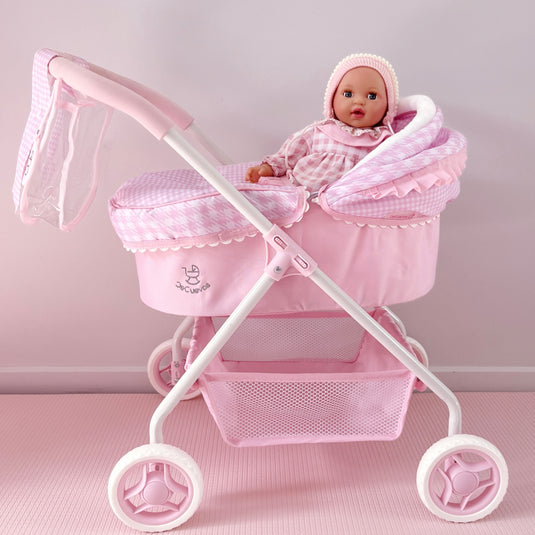The 7-Minute Rule for Dolls And Accessories
The 7-Minute Rule for Dolls And Accessories
Blog Article
Not known Details About Dolls And Accessories
Table of ContentsThe Definitive Guide for Dolls And AccessoriesThe smart Trick of Dolls And Accessories That Nobody is Talking AboutFascination About Dolls And AccessoriesLittle Known Questions About Dolls And Accessories.The Ultimate Guide To Dolls And AccessoriesSome Ideas on Dolls And Accessories You Need To KnowGet This Report about Dolls And Accessories
When dolls are consisted of in group play, kids practice waiting, sharing, and paying attention to others' ideas. Whether they're pretending to be a moms and dad, brother or sister, or good friend, youngsters learn just how connections workhow to sustain others, solve disagreements, and look after a person else. These very early role-play experiences become the groundwork for healthy and balanced relationships and connections later in life.Duplicating comforting routines with a doll (feeding, shaking, putting to bed) can help kids really feel tranquil and secure. Taking care of a doll can make a child really feel capable and confident.
Indicators on Dolls And Accessories You Should Know
When youngsters see dolls that reflect their race, heritage, and society, it enhances a favorable feeling of identity. Dolls additionally introduce children to societies outside their own, developing considerate curiosity and compassion for others.
As Dr. Karyn Purvis, a leader in kid development and trauma-informed treatment, when claimed: This powerful quote highlights just how play isn't just funit's just how kids discover ideal. The mind cables itself via rep. However when a child is engaged, joyous, and psychologically attached to an activitylike doll playthe brain strengthens those connections faster and more meaningfully.
Examine This Report on Dolls And Accessories

Young boys need empathy, kindness, and creative imagination tooand doll play uses that. Dolls are typically a youngster's first "friend," assisting them practice connections, develop communication abilities, and feel comforted.
Dolls And Accessories for Dummies
Via play. Via satisfaction. Through dolls that matter. Many thanks for joining us on this journey. Samantha Ong Samantha Ong is the owner of Joeydolls, a Canadian-based plaything brand name on an objective to celebrate Oriental cultures with joyous, comprehensive play. Motivated by her own experiences maturing without cultural depiction, Samantha develops dolls that help children really feel honored of that they are while triggering inquisitiveness and compassion in others.
Playing with dolls encourages children to speak more regarding others' thoughts and emotions, a research study has actually discovered. The research suggests that playing imaginary video games with dolls could help kids create social skills, theory of mind and empathy.
Some Known Questions About Dolls And Accessories.
They were likewise most likely to address the dolls in the second person, speaking to them directly, whereas the personalities on the computer system screen they often tended to describe in the 3rd person. No difference was observed between children and girls."Internal state language can indicate that a child is considering other individuals's ideas and emotions while playing with dolls," claimed Gerson.
Which they see language usage in this respect is excellent confirmation of the theory."Mardell added that the searchings for should put on any type of type of role-play toy, instead of being specific to Barbies. "I 'd take a broader sight of what a doll is," he claimed." [Maybe] any things that the kid can spend a sense of various other right into a stuffed pet, a stove mitt that speaks with them, or perhaps a fictional close friend."Children usually start to reveal indications of interior state language around the age of 4.
6 Easy Facts About Dolls And Accessories Shown
"It ends up being vital for making and sustaining friendships, and how they pick up from their teachers, and parents."The research study also found that the children had actually increased brain task in the posterior remarkable temporal sulcus (pSTS) area when they spoke as though their dolls had ideas and sensations. The pSTS area is thought to click site be involved in the advancement of social and emotional handling abilities.
Youth is not a fixed life phase; certainly, the interpretation, significance and understanding of childhood years are all subject to alteration. By the nineteenth century one of one of the most extensive modifications was the relevance positioned on allowing kids to experience "the care free joys" of childhood years with play activities. Play was now thought about to be a crucial element of a good childhood years.
In order to fully comprehend the significance of play, one should likewise comprehend the significance of the doll. Dolls are much more than playthings made to entertain young ladies. During the 19th century appropriate playtime tasks were selected to promote intellectual, physical or emotional advancement. Dolls were especially prominent since they were believed to foster and support womanly high qualities such as compassion, caring and empathy.
The Buzz on Dolls And Accessories

It is just with historical investigations that scientists can intend to reveal and document the full array of playtime experiences. Narrating these experiences, and specifically the role of dolls, is important for presenting an extra full image of youth during the 19th century. Alarcn, Sara E - european dolls., "Kid's Play: The Role of Dolls in 19th Century Youth" (2007 )
Report this page